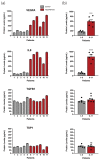Differential Gene and Protein Expression of Conjunctival Bleb Hyperfibrosis in Early Failure of Glaucoma Surgery
- PMID: 37569323
- PMCID: PMC10418990
- DOI: 10.3390/ijms241511949
Differential Gene and Protein Expression of Conjunctival Bleb Hyperfibrosis in Early Failure of Glaucoma Surgery
Abstract
The early failure of glaucoma surgery is mainly caused by over-fibrosis at the subconjunctival space, causing obliteration of the filtration bleb. Because fibrosis has a suspected basis of genetic predisposition, we have undertaken a prospective study to identify upregulated profibrotic genes in a population of glaucoma patients with signs of conjunctival fibrosis and early postoperative surgical failure. Clinical data of re-operated fibrosis patients, hyperfibrosis patients who re-operated more than once in a short time, and control patients with no fibrosis were recorded and analyzed at each follow-up visit. Conjunctival-Tenon surgical specimens were obtained intraoperatively to evaluate the local expression of a panel of genes potentially associated with fibrosis. In order to correlate gene expression signatures with protein levels, we quantified secreted proteins in primary cultures of fibroblasts from patients. Expression of VEGFA, CXCL8, MYC, and CDKN1A was induced in the conjunctiva of hyperfibrosis patients. VEGFA and IL8 protein levels were also increased in fibroblast supernatants. We propose that an increase in these proteins could be useful in detecting conjunctival fibrosis in glaucoma patients undergoing filtering surgery. Molecular markers could be crucial for early detection of patients at high risk of failure of filtration surgery, leading to more optimal and personalized treatments.
Keywords: conjunctival fibrosis; conjunctival filtration bleb; gene expression; glaucoma surgery failure; profibrotic genes.
Conflict of interest statement
The authors declare no conflict of interest.
Figures


References
-
- Allingham R.R., Damji K.F., Freedman S.F., Moroi S.E., Rhee D.J. In: Shields’ Textbook of Glaucoma. 6th ed. Williams W., editor. Walters Kluwer Lippincott; Philadelphia, PA, USA: 2012.
-
- NICE guidelines Glaucoma Diagnosis and Managment. [(accessed on 26 January 2022)]. Available online: https://www.nice.org.uk/guidance/ng81.
Grants and funding
LinkOut - more resources
Full Text Sources

